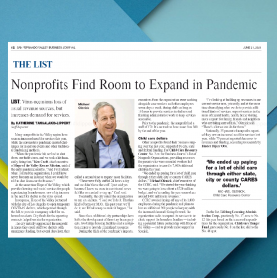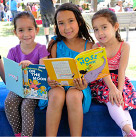7-6-21
Highlighting our ability to offer uninterrupted services to an expanded number of families and providers during the pandemic, the Child Care Resource Center is being recognized as a leading non-profit in the San Fernando Valley.
The San Fernando Valley Business Journal recently ranked CCRC as one of the top two non-profits in the San Fernando Valley. The report describes how CCRC avoided any layoffs during the pandemic and how our agency plans to hire 200 more staff by year’s end to meet growing demand.
“I’m looking at building up resources in our current service area, primarily, and at the same time diversifying what we do to provide additional kinds of services, support services in the areas of mental health, health, home visiting, more support for family, friends and neighbors who are taking care of kids,” CCRC President and CEO Dr. Michael Olenick told the Journal. “There’s a lot we can do for them.”
CCRC currently employs 1,000 professionals who serve more than 50,000 children, families and child care providers across Los Angeles and San Bernardino Counties. When state funds became available to provide child care for the children of essential workers, we immediately sprang into action to enroll an additional 7,000 children in child care.
The SFVBJ reported that 35% of nonprofits nationwide saw an increased need for services last year, while 75% experienced decreased revenue and funding. CCRC started the fiscal year expecting a budget of $320 million, however, we’re ending closer to $400 million. These added funds are a sign of trust in our work by state leaders, who are coming to see child care as a top priority.
Going forward, CCRC plans to expand services to include support for homeless families, potentially through a future partnership with Hope of the Valley, and to provide expanded support in Spanish.
Read the full report by Katherine Tangalakis-Lippert below:
The coronavirus closed thrift stores and canceled in-person fundraisers that provided revenue to Valley nonprofits. But several found ways to grow during the crisis.
Many nonprofits in the Valley region have seen an increased need for services this year, while the coronavirus pandemic created challenges for in-person events and other traditional fundraising methods.
“When the pandemic hit, we had to shut down our thrift stores, and we took a hit financially doing that,” Ken Craft, chief executive of Hope of the Valley Rescue Mission, said of the early pandemic months. “And I will admit, when I started the organization, I could have never foreseen an instance when we would be told to shut down our thrift stores.”
At the same time Hope of the Valley, which provides housing and social services for people experiencing homelessness, saw a big increase in the need for shelter as the virus spread.
In response, Hope of the Valley partnered with the city of Los Angeles to open temporary COVID-19 shelters, which operated through the fall, to provide emergency relief for unhoused residents. City funds for the operating contracts helped sustain the organization.
The city initially approached the nonprofit in hopes they could staff two shelters with emergency funding, but several days later, they called a second time to request more facilities.
“These were fully staffed 24 hours a day and we didn’t have the staff. I just said yes because I knew we were in a crisis and so we felt like we needed to step up,” Craft said.
Eventually, the city asked the organization to run six shelters. “I said we’ll do it. That has kind of been our M.O., this past year: we’ll do it, we’ll find a way to make it happen,” he said.
Since then, additional city partnerships have led to the development of three tiny home projects, two bridge housing facilities and a navigation center to provide centralized resources.
During the thick of the pandemic’s impacts, executives from the organization were working alongside case workers and other employees seven days a week, during shifts as long as 16 hours to provide services in shelters and finishing administrative work to keep services accessible.
Prior to the pandemic, the nonprofit had a staff of 170. It’s on track to have more than 300 by the end of the year.
Child care dollars
Other nonprofits found their business surging over the last year, supported by city, state and federal funding. For Child Care Resource Center, No. 2 on the Business Journal’s list of Nonprofit Organizations, providing resources for parents who were essential workers led the organization to care for 7,000 additional children this year.
“We ended up paying for a lot of child care through either state, city or county CARES dollars,” Michael Olenick, chief executive of the CCRC, said. “We started the year thinking we were going to have about a $320 million budget, and we’re ending the year somewhere around $400 million in revenues.”
CCRC avoided laying off any of its 1,000 employees during the pandemic and plans to hire an additional 200 people to keep up with the increased demand. Going forward, the organization seeks to expand its services to include support for homeless families — including a potential future partnership with Hope of the Valley — and to provide more support in Spanish.
“I’m looking at building up resources in our current service area, primarily, and at the same time diversifying what we do to provide additional kinds of services, support services in the areas of mental health, health, home visiting, more support for family, friends and neighbors who are taking care of kids,” Olenick said. “There’s a lot we can do for them.”
Nationally, 35 percent of nonprofits reported they saw an increased need for services last year, while 75percent reported decreases to revenues and funding, according to research by Binder Dijker Otte.
On the list, Lifelong Learning Administration Corp., previously No. 17, rose to No. 12 this year based on the increased expenditures for the organization. Children’s Hunger Fund, previously No. 8 on the list, slid to the No. 44 spot.



